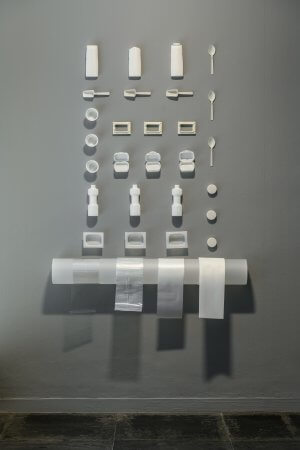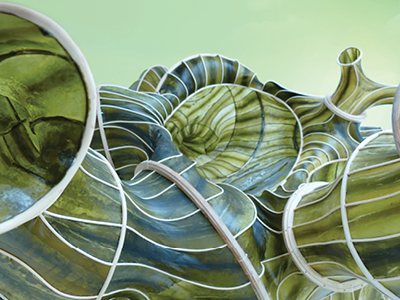Fraunhofer Institute for Applied Polymer Research IAP
Prof. Dr. Alexander Böker, Director Fraunhofer-Institut für Angewandte Polymerforschung IAP
Dipl.-Ing. Thomas Büsse, Head of Verarbeitungstechnikum für Biopolymere Schwarzheide
Dr. Jens Balko, Head of Verarbeitungstechnikum für Biopolymere Schwarzheide
Heiko Ziller, Technical co-worker
Danny Pytek, Technical co-worker
Jens Kunkel, Design of experiments and compilation of exhibits
Fabian Textor, Scientific co-worker
Fresh-keeping containers, cream jars, cable pass-throughs, and screw caps (injection molding), yogurt cups and trays (thermoforming), drink and shampoo bottles (blow molding), films (flat and blown films) made from Polybutylene Succinate
Dimensions variable
Courtesy Fraunhofer-Institut für Angewandte Polymerforschung IAP
Plastics are used in all fields of application due to their material properties, from packaging in our everyday lives to high-performance components in aerospace. They have low material density and are cost-effective to manufacture. They require less energy input compared to other materials.
In 2021 alone, the production of plastics amounted to 391 million tons, and the trend is still increasing. About 90% of the produced quantity consists of commodity plastics such as polyethylene (PE), polypropylene (PP), polyethylene terephthalate (PET), or polystyrene (PS). These thermoplastic polymers represent a significant share of end products in the chemical industry and are almost exclusively made from fossil resources.
Only about 1.5% of plastics produced in 2021 are based on renewable resources. To successfully transform from an economy based on fossil resources to a sustainable circular economy, the share of renewable resources in global plastic production must increase significantly.
A problem as yet unresolved is the amount of plastic in the environment, in rivers, seas and soils. Plastic is intentionally discarded when waste collection systems are lacking, but unintentionally, too. Large quantities also enter the environment through abrasion and wear processes. Plastic particles can be found in all sizes, down to the micro- and nanometer range. The impact on flora and fauna, including the human body, is significant.
Bioplastics are currently produced to add to, and partly replace, commodity plastics. One example of a bioplastic is Polybutylene Succinate (PBS). PBS is particularly promising because it has similar mechanical, optical, and tactile properties to oil-based commodity plastics such as PE and PP. PBS is synthesized from two monomers: succinic acid and butanediol. These basic chemical building blocks are synthesized by a process known as polycondensation.
Both materials can be made from renewable resources derived from cellulose-containing waste from agriculture and forestry. Cellulose is broken down in a process, and the resulting sugars are fermented into succinic acid and butanediol using bacteria. In this way, 100% bio-based PBS can be produced from succinic acid and butanediol. This substance, along with polylactic acid (PLA), represents an important milestone in the transition to a bio-based plastics industry.
PBS is biodegradable and exhibits similar decomposition behavior to wood under suitable environmental conditions. Bacteria metabolize and break down PBS using their enzymes, leaving behind carbon dioxide and water as degradation products. If the use of biodegradable bioplastics were to increase in the future, the concerning spread of oil-based plastics in all biotopes of our planet could be reduced.
The new production of oil-based, non-degradable plastics must be reduced as soon as possible. On the path to a fully sustainable economy, at least the rate of reuse and recycling of oil-based plastics, including bioplastics, must be top priority.
PBS, like most conventional thermoplastic plastics, can be recycled. It can be detected and sorted in modern sorting facilities. This means that a prerequisite for the recycling of all plastics is a modern facility with optical material recognition techniques in place and waste separation already carried out by consumers.
Recovered PBS can be incorporated into new products. Fraunhofer IAP collaborates with industrial partners to increase the variety of PBS types and so expand the range of applications. Using PBS does not require new processing technologies. The bio-based material can be used for injection molding, film production, blow molding and thermoforming. The sustainable materials developed at IAP are on the verge of being launched on the market.


